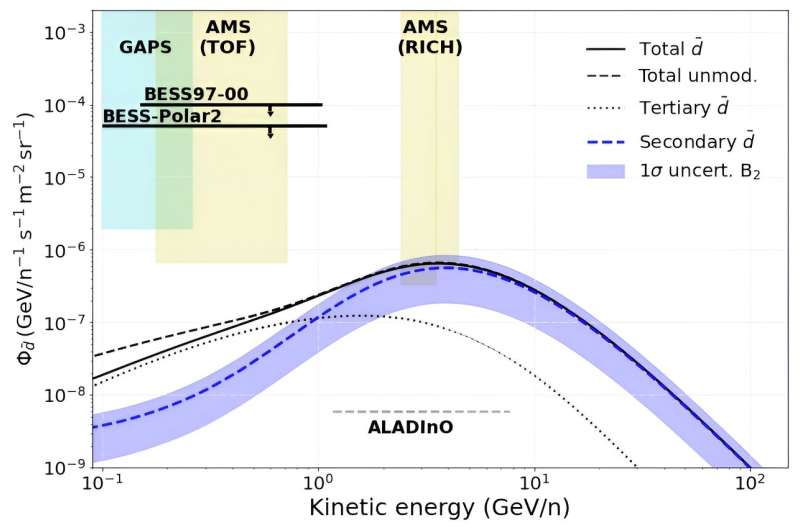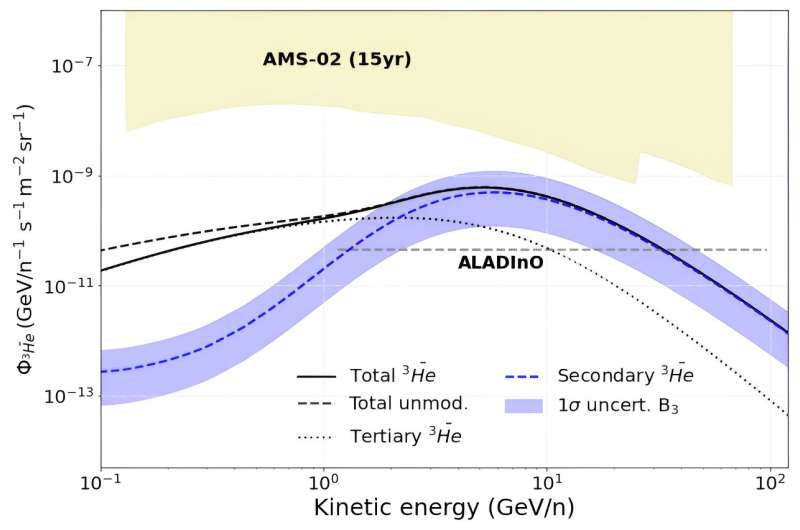One of the great challenges of modern cosmology is to reveal the nature of dark matter. We know it exists (it constitutes more than 85% of the matter in the universe), but we have never seen it directly and still do not know what it is.
A study published in the Journal of Cosmology and Astroparticle Physics has examined traces of antimatter in the cosmos that could reveal a new class of never-before-observed particles, called WIMPs (Weakly Interacting Massive Particles), which could make up dark matter.
The study suggests that some recent observations of “antinuclei” in cosmic rays are consistent with the existence of WIMPs, but also that these particles may be even stranger than previously thought.
“WIMPs are particles that have been theorized but never observed, and they could be the ideal candidate for dark matter,” explains Pedro De la Torre Luque, a physicist at the Institute of theoretical physics in Madrid.
A few years ago, the scientific community hailed a “miracle.” WIMPs seemed to meet all the requirements for dark matter, and it was thought—once it was “imagined” what they could be and how they could be detected—that within a few years we would have the first direct evidence of their existence.
On the contrary, research in recent years has led to the exclusion of entire classes of these particles, based on their peculiar emissions. Today, although their existence has not been entirely ruled out, the range of possible WIMP types has narrowed significantly, along with the methodologies for trying to detect them.
“Of the numerous best-motivated proposed models, most have been ruled out today and only a few of them survive today,” says De la Torre Luque.

A recent discovery, however, seems to have reopened the case. “These are some observations from the AMS-02 experiment,” De la Torre Luque explains. AMS-02 (Alpha Magnetic Spectrometer) is a scientific experiment aboard the International Space Station that studies cosmic rays. “The project leaders revealed that they detected traces of antinuclei in cosmic rays, specifically antihelium, which no one expected.”
To understand why these antinuclei are important for WIMPs and dark matter, one must first understand what antimatter is.
Antimatter is a form of matter with an electrical charge opposite to that of “normal” matter particles. Ordinary matter is made up of particles with negative electric charge, like electrons, positive charge (protons), or neutral charge.
Antimatter is composed of “mirror” particles with opposite charges (a “positive” electron, the positron, a “negative” proton, etc.). When matter and antimatter meet, they annihilate each other, emitting strong gamma radiation.
In the universe, composed overwhelmingly of normal matter, there is a small amount of antimatter, sometimes closer than one might think, given that positrons are used as contrast agents for PET, the medical imaging exam that some of you may have undergone.

Some of this antimatter was formed—scientists believe—during the Big Bang, but more is constantly created by specific events, which makes it very significant to observe. “If you see the production of antiparticles in the interstellar medium, where you expect very little, it means something unusual is happening,” De la Torre Luque explains. “That’s why the observation of antihelium was so exciting.”
What produces the antihelium nuclei observed by AMS-02 could indeed be WIMPs. According to the theory, when two WIMP particles meet, in some cases they annihilate, meaning they destroy each other, emitting energy and producing both matter and antimatter particles.
De la Torre Luque and his colleagues have tested some of the WIMP models to see if they are compatible with the observations.
The study confirmed that some observations of antihelium are hard to explain with known astrophysical phenomena.
“Theoretical predictions suggested that, even though cosmic rays can produce antiparticles through interactions with gas in the interstellar medium, the amount of antinuclei, especially antihelium, should be extremely low,” De la Torre Luque explains.
“We expected to detect one antihelium event every few tens of years, but the around ten antihelium events observed by AMS-02 are many orders of magnitude higher than the predictions based on standard cosmic-ray interactions. That’s why these antinuclei are a plausible clue to WIMP annihilation.”

But there may be more. The antihelium nuclei observed by AMS-02 are of two distinct isotopes (the same element, but with a varying number of neutrons in the nucleus), antihelium-3 and antihelium-4. Antihelium-4, in particular, is much heavier and also much rarer.
We know that the production of heavier nuclei becomes increasingly unlikely as their mass increases, especially through natural processes involving cosmic rays, which is why seeing so many of them is a warning sign.
“Even in the most optimistic models, WIMPs could only explain the amount of antihelium-3 detected, but not antihelium-4,” De la Torre Luque continues, and this would require imagining a particle (or class of particles) even stranger than the WIMPs proposed so far, or in technical jargon, even more “exotic.”
Thus, De la Torre Luque and his colleagues’ study indicates that the path toward WIMPs is not yet closed. Many more precise observations are now needed, and we may have to expand or adapt the theoretical model, perhaps introducing a new dark sector into the standard model of known particles to date, with new “exotic” elements.
More information:
Pedro De La Torre Luque et al, Cosmic-Ray Propagation Models Elucidate the Prospects for Antinuclei Detection, Journal of Cosmology and Astroparticle Physics (2024). On arXiv: DOI: 10.48550/arxiv.2404.13114
Citation:
Traces of antimatter in cosmic rays reopen the search for ‘WIMPs’ as dark matter (2024, October 4)
retrieved 4 October 2024
from https://phys.org/news/2024-10-antimatter-cosmic-rays-reopen-wimps.html
This document is subject to copyright. Apart from any fair dealing for the purpose of private study or research, no
part may be reproduced without the written permission. The content is provided for information purposes only.

